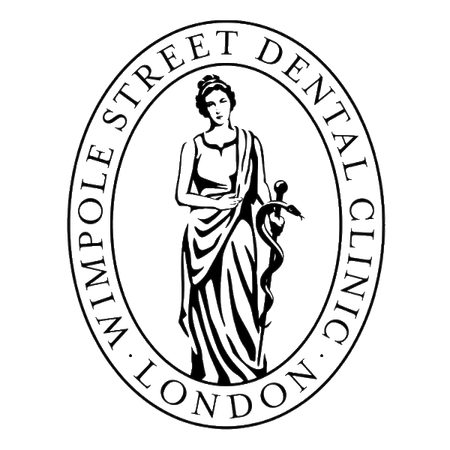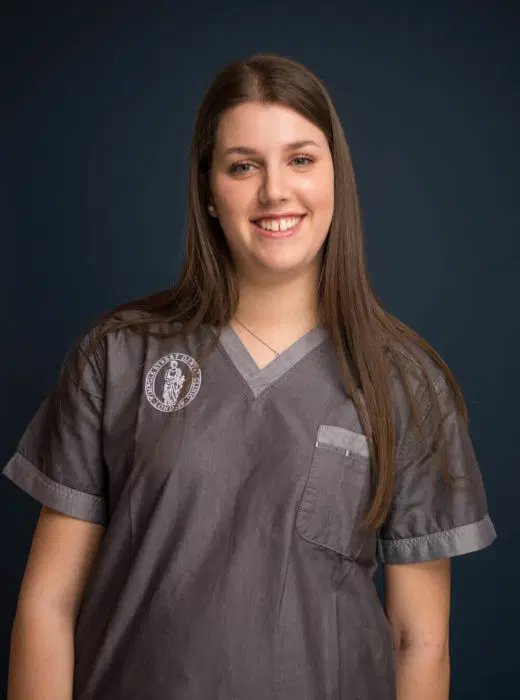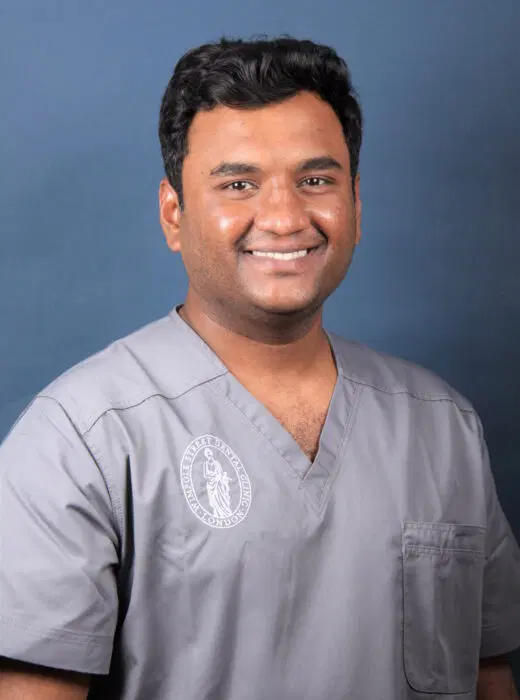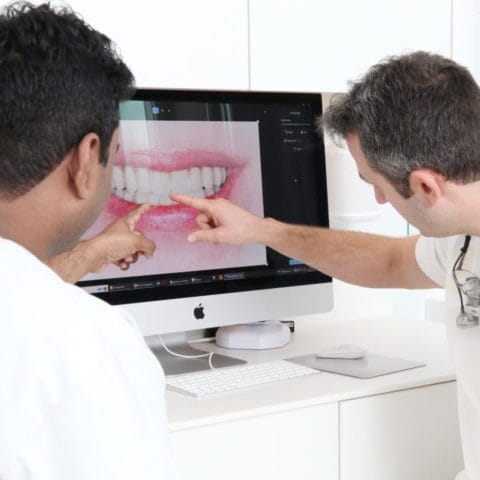Gum Correction in London
Gums play a crucial role in the appearance of anyone’s smile. Light pink gums not only provide a beautiful frame for the teeth but also give us the first impression of a healthy mouth. However, sometimes the gums become damaged due to poor hygiene, defective restorations or gum recession. Some patients also naturally have excessive gum tissue due to a condition called altered eruption. This can make the teeth look small and affects the appearance of the smile.

Treatment
90 minutes

Price
From £1,200

Team Experience
25+ Years

Recovery Time
5+ Days

Google Rating
★★★★★ (4.9)
Examples of our work
Gum correction can significantly enhance the balance and appearance of a smile by reshaping uneven or excess gum tissue. At Wimpole Street Dental Clinic, our gum correction case studies illustrate the personalised approach we take to refine and contour gums, creating harmonious results that highlight the natural beauty of each patient’s teeth. Each case demonstrates how our skilled team helps patients achieve a more balanced, confident smile.

Gums play a crucial role in the appearance of anyone’s smile. Light pink gums not only provide a beautiful frame for the teeth but also give us the first impression of a healthy mouth. However, sometimes the gums become damaged due to poor hygiene, defective restorations or gum recession. Some patients also naturally have excessive gum tissue due to a condition called altered eruption. This can make the teeth look small and affect the appearance of the smile.
What is Gum Reshaping & Correction?
Gum reshaping and correction treatments are among the safest surgical procedures in the dental world. During the initial check-up, an evidence-based treatment plan is created by your dentist to help achieve the results you want. We need to understand exactly what parts of your smile you want to have improved and what treatment option is best suited for the task.
Gum reshaping and correction treatments are usually performed microsurgically using magnifying optical systems and under local anaesthesia. The procedures themselves are usually pain-free. There are several treatment options depending on your requirements:
- Gum graft – to correct receding gums.
- Gingival correction – to correct asymmetric gums.
- Gummy smile treatment – to correct the appearance of “too much gum”.
- Stillmann Cleft treatment – to correct visible damage or trauma to the gum.
- Missing keratinised (attached) gingiva treatment.
- Laser gum contouring – to correct an uneven gum line.
- Discoloured gum treatment – to correct unwanted discolouration of the gum.
- Excessive gum growth – to correct the unwanted prominence of the gum, usually caused by medication.
We have a post-operative pain management concept which is very successful at keeping pain levels down. After about a week, the healing process is complete, and we can remove the sutures. You will see the result after about four to eight weeks.
Meet your award-winning Gum Correction dentist and team…
- We have over 75+ years of combined dentistry experience across our specialist team.
- 10,000+ treatments performed and counting.
- We are leaders in the dental industry – we regularly teach, lecture and publish our research work internationally.
Our Expertise
Our dental specialists in our clinic in the heart of the medical district here in London combine nearly a century of experience and hundreds of periodontal (gum) operations between them.
In addition, our ultramodern high-tech set-up, state-of-the-art facilities, numerous national and international publications and performing all procedures under magnification make our clinic one of the most superior centres to receive this specialised treatment.
Our commitment to quality, patient comfort, and advanced dental practices makes us the preferred choice for those seeking the best in oral health care.
Our clinic is conveniently located in the heart of Marylebone, Central London and is accessible by car, taxi, bus, Tube and on foot.
Contact us today to arrange an initial consultation so that our expert and experienced dentists can examine your gums, discuss your issue and diagnose a correct treatment plan suitable to your circumstances.

Helen Li
Wimpole Street Dental has the highest most ethical standard of work, personable approach, clear and safe procedures, top notch excellence and reliability in treatment provided with utmost professionalism from crème de la crème world class specialists all under one roof.
How do we identify what gum correction is right for you?
The first step we undertake is a thorough and robust examination of your gums, followed by a diagnosis of the potential problem. We always invite patients for an initial consultation to perform the examination, discuss their issue and explain the variety of potential causes and treatment options suitable to their circumstances.
Once we have agreed upon the most suitable treatment plan, we can help our patients visualise the result either with an imitation of the final situation on a stone plaster model (known as a wax-up) or a virtual aesthetic plan (Digital Smile Design®, digital smile planning). Thanks to this innovative technology, we can not only analyse the problems in the best possible way and determine the necessary corrections, but also simulate the aesthetic changes before the actual treatment starts and discuss them with you.
In some instances, we may need to first address other factors that are the likely cause of the gum issue. For example, if the bone and root surface covering the gum is receding due to grinding or periodontal disease or a combination of both, it is important to first address and solve these issues before starting any cosmetic procedure. As a rule, the preconditions for aesthetic gum surgery are healthy and decay-free teeth where no root canal infections are present, and no active periodontal disease can be identified.
Take your first step with Wimpole Street Dental Clinic
Discover the path to a brighter smile with Wimpole Street Dental Clinic! Our team of skilled professionals utilises advanced technology to provide personalised dental care in a comfortable setting.
Our gum reshaping & correction treatments
- Gum graft treatment
- Gummy smile treatment
- Mechanic and traumatic injuries leading to gum loss (e.g. Stillmann cleft)
- Unstable gums
- Gum contouring for uneven gum lines
- Discoloured gums
- Excessive gum growth
Gum graft treatment is used to treat receding gums. Gum recession not only can cause medical issues such as tooth sensitivity but can also be aesthetically displeasing. Common complaints from patients with recession are that they look ‘long in the tooth’ where the tooth roots are exposed as well as having ‘black triangles’ in between the teeth where the interdental gum has been lost leaving large gaps. This in turn leads to other functional problems such as food trapping and makes the teeth harder to keep clean. Since gums do not regenerate themselves, surgical correction in the form of gum grafts is the only solution to replace the gum tissue that has been lost.
To correct gum recession, there are usually two methods available:
- the transplantation of tissue – the so-called connective tissue graft from the palatal side of your upper jaw (otherwise known as the roof of your mouth).
- the stretching of tissue – the coronally advanced flap.
In most cases, both techniques are used in combination. In our clinic, all cases are planned virtually using modern technology. This allows our dentist to have a more precise analysis and offers the opportunity for patients to view the potential result of their treatment in advance.
Tissue transplant from the palate
In this procedure, your dentist will remove tissue (the graft) from the palate (roof of the mouth) and introduce it into the gums or between gums and periosteum (the outer layer of the underlying bone). Alternatively, your dentist could decide to use artificial grafts (such as Alloderm or Novomatrix) so they do not need to obtain a graft from your palate.
A small open wound remains at the removal site from where your graft has been taken but this normally heals quickly and the risk of infection is extremely low. When only using connective tissue for the transplant, the wound on the palate can be sutured with the residual gingiva (fixed gums).
The procedure takes place under local anaesthesia. Despite its complexity, the procedure itself only takes around 45 minutes to one hour to complete. After the procedure, it might be difficult brushing your teeth as you usually would for up to four to six weeks, but this is something our team can offer you support and advice on. Both methods are highly successful, however, the transplantation of connective tissue without the covering skin is usually less painful after the procedure.
Stretching of tissue
If there is enough attached gingiva (fixed gums) below the receding gum, the exposed tooth root surface can be covered without removing a transplant from the palate. This is commonly known as a “gum lift”.
In the first step, part of the gum tissue is carefully split from the underlying bone. The tissue can then be gently pulled upwards towards the enamel margin of the tooth and fixed there. Special cuts take the tension off the gum flap. The newly positioned gums are fixed with sutures so they can gradually heal. The procedure also takes place under local anaesthesia.
A gummy smile is where there is too much gum visible to high upper lip mobility (high muscle pull). The key components that dictate your smile aesthetics are the teeth, lips, jaws, and gums. Each key component needs to be in harmony with the other. If one of the conditions behind a gummy smile is genetic there is not much you can do to prevent it from happening, but there are plenty of options to correct it.
Gummy smiles can be caused by several reasons including a genetically small upper lip, teeth that are small in comparison to the gum due to wear or genetics, enlarged gums, an overgrown upper jaw or where teeth may not be fully erupted and remain partially covered by gum tissue.
The appropriate treatment for a gummy smile or excess gum tissue will depend on what is causing it.
Options include:
- If the underlying reason for “too much visible gum” is mild and due to the jaws or teeth, it can sometimes be fixed with braces or invisible braces such as Invisalign to shift the bite into the correct position and make the gums appear less prominent.
- In case of a more severe jaw protrusion, the best course of action is orthognathic surgery. This involves an oral surgeon re-contouring the upper jaw so that it is the correct size and then moving it upward into its ideal position before securing it with plates and screws.
- Veneers, fillings, or crowns can make the teeth appear longer and improve the tooth-to-gum ratio if the teeth are too short due to wear or genetics.
- If too much gum tissue is the issue, a dentist or periodontist can perform gum reshaping by removing a little bit of the gums. In this procedure, the dentist removes the extra gum tissue and reshapes it to expose more of the teeth and improve the look of your smile.
- Crown-lengthening surgery can be used to contour the bone and the gums by removing gum tissue and/or bone to expose more teeth and let the gums retract back to their correct position. This gummy smile correction procedure is usually conducted under local anaesthetic injection. After three months a small gum reshaping might be needed. This procedure can be accompanied by veneers and/or teeth whitening.
- Lip repositioning surgery followed by orthodontic treatment can be a good alternative to jaw surgery if the gummy smile is the result of a short or hyperactive upper lip.
- In the case of a hypermobile upper lip, Botox can be used as a more affordable gummy smile treatment option than surgery. However, the results are temporary and last about three to four months and it will only work when the upper lip is the reason for the exposed gums. A doctor injects the lip with Botox, which paralyses the muscle and prevents it from lifting too high when you smile.
All our dentists and specialists have the experience necessary to understand the cause of your gummy smile and will also consider all the components of your smile and ensure they are harmonious.
During your initial consultation, your dentist will perform a comprehensive examination of your teeth, lips, jaws, and gums, give you a diagnosis and help you decide on the best treatment option for your needs.
We are well-versed in taking a team approach with other in-house dental health professionals, so if you require the services of a periodontist, cosmetic dentist, or oral surgeon, we can ensure the process runs smoothly and without any inconvenience.
Sometimes you may hurt your gums by brushing too hard or slipping and injure your gums thus causing a “gingival recession” (otherwise known as receding gums). In such instances, your dentist may recommend a treatment plan of two gum grafts to rectify the problem.
The first graft re-establishes the damaged tissue, while the second gum tissue graft is harvested raising a small flap in the palatal side of your upper jaw and removing a small part of the underlying tissue – the so-called connective tissue graft.
These small procedures stabilise the situation and can prevent any further gum disease or recession.
The top part of the gums right next to the neck of the tooth is used quite heavily while chewing and is firmly attached to the underlying bone and the tooth. Gum disease, grinding your teeth or accidents lead to the loss of this tissue, especially around dental implants. This in turn can lead to bacteria entering through the gum and potentially causing inflammations and gum disease.
To re-establish the gum a small flap is raised in the upper jaw and a small piece of skin is taken out and transplanted to the lower jaw. This small tissue grafting procedure under local anaesthetic is usually completely painless. After removing the gum graft the wound is sensitive to spicy food for a few weeks.
Sometimes our patients may have a slightly uneven gumline that despite its small imperfection can lead to the patient feeling self-conscious and low in confidence about their smile. Gum reshaping under local anaesthetic with either a scalpel (called gingivectomy) or a laser (laser gum contouring) can be used to correct that. As dental procedures go, gum reshaping is extremely safe and has an extremely low risk of infection.
In some rare circumstances, amalgam filling material has been used to fill dental roots retrospectively when conducting apicectomies (cutting the inflamed tip of a tooth root).
The silver part of the amalgam sometimes diffuses into the soft tissue and discolours them with a silver/grey colour. In a small surgical procedure, the discoloured tissue is removed and a graft from the palate (the roof of your mouth) replaces the missing tissue.
Some patients often report excessive gum growth that is caused by medication. Below you can find a list of medications which can cause medication-induced gum growth. If multiple drugs are given together, they could aggravate the condition.
- Phenytoin (PHT, or 5,5-diphenylhydantoin)
- Sodium valproate
- Phenobarbitone
- Vigabatrin
- Primidone
- Mephenytoin
- Ethosuximide
The most effective treatment for drug-related gum enlargement is withdrawal or substitution of the medication. When this treatment approach is taken, it may take from 1 to 8 weeks for your gums to return to their original state.
New page design
Written by: Prof Dr Christian Mehl
Medically reviewed by: Dr Raul Costa
Author biography added
Written by: Prof Dr Christian Mehl
Medically reviewed by: Dr Raul Costa
Original content created
Written by: Prof Dr Christian Mehl
Medically reviewed by: Dr Raul Costa
Wimpole St Dental Clinic has strict sourcing guidelines and relies on peer-reviewed studies, academic research institutions, and medical associations. We avoid using tertiary references. You can learn more about how we ensure our content is accurate and current by reading our editorial policy.
- Mehl C, Kern M, Zimmermann A, Harder S, Huth S, Selhuber-Unkel C. Impact of Cleaning Procedures on Adhesion of Living Cells to Three Abutment Materials. Int J Oral Maxillofac Implants. 2017 Sep/Oct;32(5):976-984. doi: 10.11607/jomi.5630. PMID: 28906501.







